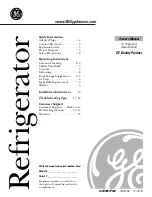
13
TROUBLESHOOTING
You can solve many common problems easily, saving you the cost of a possible service call. Try the
suggestions below to see if you can solve the problem before calling the servicer.
The unit stops
working.
Check whether the appliance is connected to power or whether the
plug is in well contact.
Check whether the voltage is too low.
Check whether there is a power failure or partial circuits have tripped.
There is an odor
inside the unit.
Tightly wrap food to prevent possible odor.
Check whether there is any rotten food. Clean
the inside of the appliance.
The compressor
runs too long.
Long operation of the compressor is normal in summer when the ambient
temperature is high.
It is not recommended to load a large amount of food in the appliance at
one time. Cool food to room temperature before loading into the
appliance.
The doors are opened too frequently.
Light fails to turn on
Check whether the appliance is connected to power supply and
whether the illuminating light is damaged.
Doors cannot be
properly closed
The door is blocked by food packages.
The appliance is not level.
Loud noise
Check whether the floor is level and whether the appliance is placed
stably. Check whether accessories are placed at proper locations.
Door seal fails to
be tight
Remove foreign matters on the door seal.
Heat the door seal and then cool it for restoration (ex: blow it with
an electrical drier or use a hot towel for heating).
Water pan overflows
There is too much food in the chamber or the food stored contains
too much water, resulting in heavy defrosting.
The doors are not closed properly, resulting in frosting due to the
entry of air and increased water due to defrosting.
Hot housing
Heat dissipation of the built-in condenser via the housing, is normal.
When the housing becomes hot due to high ambient temperatures and the
storage of too much food, it is recommended to provide sound ventilation
to facilitate heat dissipation.
Surface condensation
Condensation on the exterior surface and door seals of the appliance
is normal when the ambient humidity is too high. Just wipe the
condensate with a clean towel.
Abnormal noise
Buzz: The compressor may produce a buzzing noise during operation, and
the buzzes are loud particularly upon start or stop. This is normal.
Creak: Refrigerant flowing inside of the appliance may produce a creaking
sound, which is normal.
If you've checked the table above and find that you still need help with your appliance, call our
Customer Service facility at
800-932-4267
between 9:00AM and 5:00PM ET. We will do our best to
answer your questions.
Summary of Contents for FF101W
Page 14: ...14 NOTES ...
Page 15: ...15 NOTES ...


































